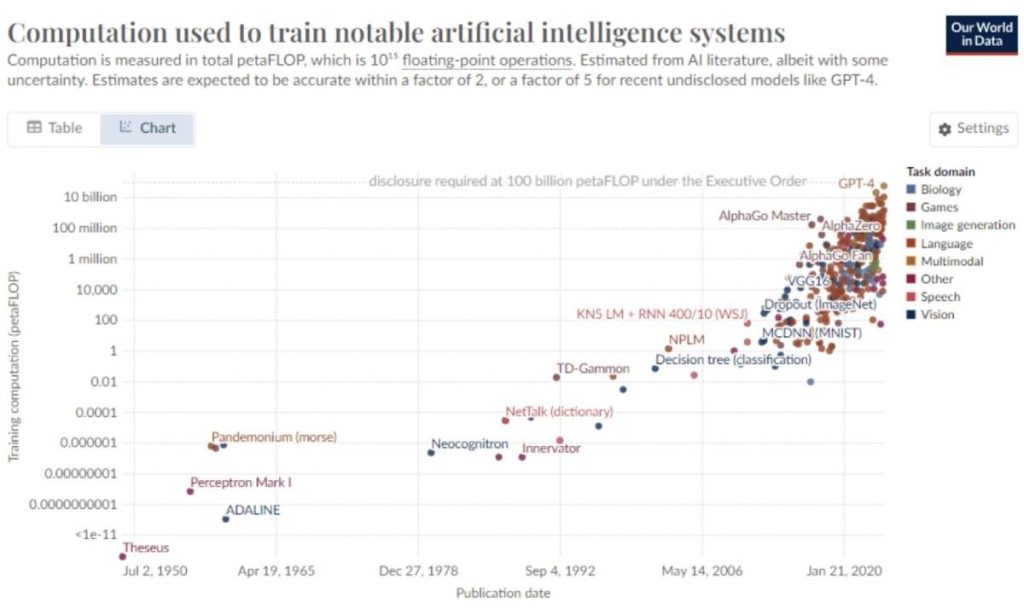DePIN, or distributed computing, is emerging as one of the hottest areas in the crypto industry in 2024. With the potential for widespread adoption, DePIN projects are versatile, and the combination with AI is the new breakthrough that projects are exploiting. Today, let’s join Coincu to learn about the top outstanding DePIN AI projects that can explode in the near future.

What is DePIN?
Decentralized Physical Infrastructure Networks (DePIN) are the new generation of blockchain-based solutions that decentralize traditional physical infrastructure. They decentralize critical services, such as storage and wireless connectivity, into networks that will one day revolutionize how these resources are managed and used.
DePIN’s focus is on integrating decentralized blockchain technology with physical infrastructure. Through the distributed ledger capabilities of blockchain, DePIN creates a more flexible and resilient framework for managing complex physical infrastructure.
AI in Crypto
As business tasks become increasingly complex, AI models must utilize larger computational resources, potentially increasing exponentially.

Some classic cases that require substantial computational power include deep learning, autonomous driving, AI agents, and more.
However, the computational power necessary for these advancements is currently limiting the extraordinary development of AI. Companies aiming to dominate the AI or machine learning sector must invest significantly in computational resources.

This has led to a surge in demand for GPUs. Simply put, a GPU is a crucial resource for AI data computation/processing. This is also why NVIDIA, the leading company in GPUs, has seen remarkable growth, surpassing even Apple’s market position in the recent period.
However, it can be said that GPUs are a luxury playground for large-scale enterprises. SMEs find it challenging to compete because this cost is a considerable burden.
As a result, the crypto market welcomes a highly potential niche: decentralized computing. This is also the intersection of the DePIN AI trends.
Decentralized computing deploys models using GPU clusters spread across the globe, with costs being a fraction of centralized services/infrastructure like Google Cloud, AWS, etc. Now, let’s look at some prominent names in this trend.
List of Featured DePIN AI Projects
1. Bittensor (TAO)
Bittensor is a layer 1 blockchain specifically designed to store AI data. Its architecture is similar to that of Avalanche—there is a main blockchain and several subnets interconnected to it. In such a structure, the subnets on the Bittensor store AI data like text, images, etc., which are shared in the Bittensor blockchain, thus creating a decentralized network for AI data.
According to the project, most AI data from companies like OpenAI, Google, and others cannot be shared externally. If a company wants to build AI, they need to invest significant resources initially. Therefore, Bittensor’s goal is to leverage blockchain’s transparency and data-sharing capabilities to help businesses more easily develop AI. This propels Bittensor to be one of the top DePIN AI projects today.
Read more: Bittensor Review: Machine Intelligence’s Future Unveiled?
2. Io.net (IO)
Io.net is the next name on the list of top DePIN AI projects. Io.net introduces itself as the Internet of GPUs, essentially a cloud computing network that provides computational power for companies in the AI/ML field.
The project has raised $30 million in a Series A round from major crypto market funds such as Multicoin Capital, OKX Ventures, HackVC (lead), and Animoca Brands. It also featured on Binance Launchpool number 55, garnering significant attention from the investment community.
One of KIP Protocol’s most notable partners is Masa Network. With this collaboration, the community is hopeful that these two prominent names in Animoca Brands’ portfolio will create remarkable achievements.
Read more: io.net Review: Notable DePIN Project In The Solana Ecosystem
3. Masa Network (MASA)
Masa Network is a platform for exchanging personal data between Web3 users and AI companies worldwide. You can think of Masa as a data marketplace. What problem is Masa addressing? It is tackling the issue of personal information security when using social media and Web3.
In the past, big tech companies considered user data as their asset. Now, they will have to pay to purchase or rent this data for AI training. Conversely, users have ownership of their personal data and can earn passive income from it.
Masa Network has proudly won two major Web3 competitions: Binance MVB Incubator and CoinList Seed Incubator. Masa successfully raised $9.4 million through competition from prominent organizations and individuals in the crypto market.
Since its launch in Q3/2022, Masa has achieved impressive results, including over 1.2 million active wallets, contributing 23 million data points, partnering with more than 70 ecosystem partners, and supporting over 8 blockchains. Masa is one of the DePIN AI projects with a very stable growth rate.
4. Kip Protocol (KIP)
KIP Protocol is an infrastructure that provides data for AI training, with this data source being referred to as a knowledge asset.
KIP previously won the Chainlink Hackathon 2023, allowing the project to raise $140,000 from node sales. Before that, KIP had already received investments from funds such as Animoca Brands and SkyVision.
5. Ankr (ANKR)
Ankr is the only platform that combines node infrastructure, staking, and DeFi to simplify dApp development and make Web3 more accessible to everyone. Additionally, Ankr is developing its own blockchain aimed at AI.
The Ankr ecosystem is expanding rapidly, with over 55 blockchains already integrated and more being added continuously. The Ankr product lineup includes: – Web3 API – Staking – Scaling Service – NeuraAI
Ankr offers a solution using distributed cloud computing network (DCCN) technology. According to the dev team, this technology can be easily integrated with computing resources to form a unified resource cloud.
With a robust development team, extensive blockchain integration, and cutting-edge advancements in AI and other emerging crypto sectors, Ankr is poised to become a dominant player in the bull market.
Read more: Ankr Review: Making Web3 Grow Stronger
6. Covalent (CQT)
Covalent is an established project that emerged during the 2020-2021 cycle, specializing in providing Web3 data infrastructure for AI. I highly appreciate this project because they have survived the harsh downtrend of 2022-2023 and are expanding their AI service branch, catching up with the common market trend.
Covalent currently supports over 225 networks. Recently, the project recorded a milestone with 300 million active wallet addresses interacting with their data, a 20% increase from last year. Additionally, Covalent has launched the Ethereum Wayback Machine, a notable on-chain data tracking service.
On June 11, 2024, Arthur Hayes (Co-founder of BitMEX) officially became a strategic advisor for Covalent. Furthermore, this advisor values $CQT highly and wishes to receive his salary in this token.
7. Aethir (ATH)
A prominent name in Q2 2024 is Aethir (ATH), a decentralized computing infrastructure that specializes in providing services to enterprise clients in the AI and gaming sectors.
Aethir’s model is straightforward: it aggregates idle GPUs from various sources, both individual and organizational, and then efficiently redistributes them to parties in need of GPU rental. In crypto terminology, this is referred to as GPU-as-a-service.
Thanks to Aethir’s solution, developers can significantly reduce the high costs associated with data processing and storage, particularly in the gaming sector. This, in turn, creates a smooth and seamless experience for gamers (end-users). So, Aethir is one of the best user-friendly DePIN AI projects out there.
8. Worldcoin (WLD)
Worldcoin is developing, with its cutting-edge protocol, a new paradigm in the management of personal identity. At the core of Worldcoin’s technology is a device created to scan the retina of users called the Orb. Proof of Personhood is intrinsic to Worldcoin’s system, letting people prove digital uniqueness.
Worldcoin is building a global identification and financial system where everyone gets easy access to cryptocurrency by “retina scanning” and is rewarded in return with the project’s WLD tokens.
Identity information of users is then securely stored on the blockchain upon verification. Worldcoin designed its products to help people engage with the emerging decentralized economy.
The inspiration of Worldcoin came from its co-founders, Sam Altman, CEO of OpenAI, and Alex Blania. They envisioned a digital identification protocol that would enable differentiation between a real human and AI. The project developed the Orb, which scans the retina of users to provide each user with a unique digital identification “passport” called World ID.
Read more: Worldcoin Review: The New Project Expected To Boom In 2024
Benefits of Promoting DePIN AI Projects
Decentralized physical infrastructure networks combined with artificial intelligence are the force in modern infrastructures.
AI Machine Learning Models
AI technologies are an integral part of DePIN system optimization. The high-end pattern recognition and decision-making ability of machine learning models like neural networks, decision trees, and deep learning algorithms drive the DePIN solutions to work with increased intelligence and efficiency, thus significantly enhancing infrastructure performance.
Training for the DePIN AI applications, on the other hand, requires large and—importantly—diverse dataset collection. Of importance is the continuous learning component, whereby the models improve on their information from new input, therefore continually gaining in accuracy.
Other techniques applied for model improvement in order to increase performance, hence remaining practical, in changing environments include reinforcement learning and supervised learning.
Data Privacy and Security
Data privacy has become the most critical concern in DePIN AI systems. Some techniques to achieve this are differential privacy and federated learning. These will all serve to ensure the hitherto protection of sensitive pieces of information while the models are still learning from user data. That is essentially to mean that such approaches are critical in building trust and compliance with the provisions for data protection, such as the GDPR.
Decentralized Governance
AI also embodies decentralized governance in DePIN ecosystems. AI models process large reams of data in order to derive valuable insights into the governance framework. AI-driven smart contracts ensure rules and policies are executed precisely in a manner that fosters a self-sustaining governance structure—decentralization and community involvement.
Conclusion
Integration of DePIN with AI, therefore, is a key trend in the future of technologies. These projects, which have security, scalability, and decentralization at the forefront, gain immense attraction among investors and traders alike in the cryptocurrency market.
With increasing demands for decentralized solutions, DePIN AI projects will turn out to be all the more crucial. They are in a position to offer a very promising avenue for one seeking to diversify his or her cryptocurrency portfolios. With the combination of innovative capabilities brought on board by AI and the robust DePIN framework, such projects will pave the way for a transformational shift in the crypto space.
| DISCLAIMER: The information on this website is provided as general market commentary and does not constitute investment advice. We encourage you to do your own research before investing. |




